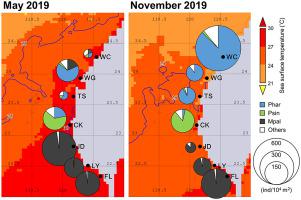Estuarine, Coastal and Shelf Science ( IF 2.6 ) Pub Date : 2021-04-08 , DOI: 10.1016/j.ecss.2021.107356 Hsu-Sen Chen , Kuo-Shu Chen , Chiee-Young Chen , Chin-Chang Hung , Pei-Jie Meng , Meng-Hsien Chen

|
Two Ocean Researcher No.3 research vessel cruises were conducted at seven sites set along the western coastal waters off Taiwan in May (late spring) and November (late autumn) 2019, to elucidate the spatiotemporal variation of the benthic shrimp assemblages. Among the 27 recorded shrimp species, the species number was higher in late autumn (20 species) due to the appearance of several oligothermal shrimps, than in late spring (15 species) with only polythermal tropical shrimps. Two shrimp assemblages, the North group and South group, were identified in the nearshore coastal waters off western Taiwan with distinct dominant shrimp species. Their spatiotemporal distribution reflects the large-scale seasonal water temperature variation driven by the cold China Coastal Current (CCC), and the warm Kuroshio Branch Current (KBC) and South China Sea Surface Current (SCSSC), as well as the shrimp preference for sediment grain size. The North group is situated north of Chiku (Qigu) (23°09′N), which is the cold CCC southbound limit in winter, and is composed mainly of subtropical shrimps, dominated by Parapenaeopsis hardwickii and P. sinica. The South group is located south of Jiading (Qieding) (22°52′N), which is annually affected by the warm KBC and SCSSC, heating the water temperature to >25 °C, even in winter, except for January. The South group is composed of mainly tropical shrimps dominated by Metapenaeopsis. palmensis, which cannot live in water temperatures <25 °C. This is the first report of tropical-subtropical shrimp assemblages formed in conjunction with the large-scale variation of the water mass and current-driven sediment grain size on a seasonal and geographical location basis. It is also shown that P. hardwickii made a northward retreat of ca. 0.5oN in the past two decades, and the baseline has been set to study the north-range shift of the tropical shrimps in the future in this location.
















































 京公网安备 11010802027423号
京公网安备 11010802027423号